
Catalog excerpts
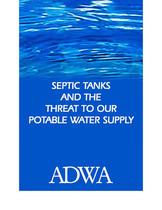
SEPTIC TANKS AND THE THREAT TO OUR POTABLE WATER SUPPLY ADWA
Open the catalog to page 1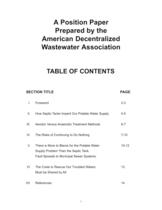
1 A Position Paper Prepared by the American Decentralized Wastewater Association TABLE OF CONTENTS I. Foreword 2-3 II. How Septic Tanks Imperil Our Potable Water Supply 4-5 III. Aerobic Versus Anaerobic Treatment Methods 6-7 IV. The Risks of Continuing to Do Nothing 7-10 V. There is More to Blame for the Potable Water 10-12 Supply Problem Than the Septic Tank. Fault Spreads to Municipal Sewer Systems. VI. The Costs to Rescue Our Troubled Waters 13 Must be Shared by All VII. References 14 SECTION TITLE PAGE
Open the catalog to page 2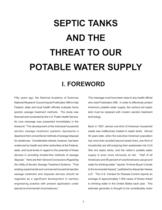
Fifty years ago, the National Academy of Sciences National Research Council issued Publication 586 to help Federal, state and local health officials evaluate home aerobic sewage treatment methods. The study was financed and conducted by the U.S. Public Health Service. Its core message was presented immediately in the foreword: “The development of the individual household aerobic sewage treatment systems represents a departure from conventional methods of sewage disposal for residences. Considerable interest, however, has been evidenced by health and other authorities at the Federal, state,...
Open the catalog to page 3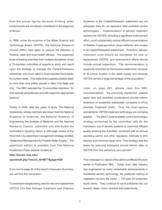
than the actual figures because drinking water contaminants are not always considered in the diagnosis of illness.” In 1998, under the auspices of the Water Science and Technology Board (WSTB), the National Research Council (NRC) tried again to capture the attention of Federal, state and local health officials. This esteemed body of leading scientists from multiple disciplines chose a 15-member committee of experts to study and report upon the strategy to manage the Catskill/Delaware watershed, one of our nation’s most important boundaries for surface water. This watershed supplies potable...
Open the catalog to page 4
C. Knox, “Septic Tank System Effects on the Quality of Ground Water”, Lewis Publishers, Inc. Despite decades of work to reduce pollution from industries, sewage plants and runoff, the nation’s potable water supply remains in jeopardy. The biggest problems still occur whenever it rains as untreated sewage runs into our drinking water supplies from cesspools and deteriorating septic systems. According to the U.S. Geological Survey, the earth’s surface is 71% water, but only 2.5% of that volume is potable. Of that potable water supply, nearly 70% is ice and almost 30% is subsurface, held both...
Open the catalog to page 5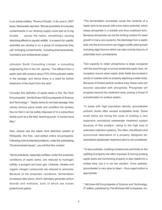
“The fermentation processes cause the contents of a septic tank to be anoxic with a low redox potential, which keeps phosphate in a soluble and thus mobilized form. Because phosphate can be the limiting nutrient for plant growth in many eco-systems, the discharge from a septic tank into the environment can trigger prolific plant growth including algal blooms which can also include blooms of potentially toxic cynobacteria. “Soil capacity to retain phosphorus is large compared with the load through a normal residential septic tank. An exception occurs when septic drain fields are located in...
Open the catalog to page 6
nutrients which would otherwise cause eutrophication of the river in which the treated effluent is discharged.” * In comparing the two treatment methods in a technical brief published on July 29, 1999, The WELL Resource Center for Water, Sanitation and Environmental Health — which is funded by the United Kingdom’s Department for International Development and managed by Loughborough University in Leicestershire, UK — came to this conclusion: “The main disadvantages of the anaerobic processes are that they are much slower than aerobic processes and are only good at removing the organic waste...
Open the catalog to page 7
When we refer to clean, safe water, we do not mean “clean” in the chemical sense. We are alluding to a dynamic balance between the nonliving macro-nutrientscarce matter and the living organisms in water. This balance in relationships of life forms to one another, perhaps developed over the course of a couple of billions of years, are always changing; but they are also persistently striving for equilibrium as they expand in healthy diversity. Today, most of the waters on Earth are dreadfully unhealthy. Scientific study sponsored by United Nations Food and Agriculture Organization and...
Open the catalog to page 8
What happened to make all this so? In brief, there was a sudden infusion (sudden compared to the slow pace of evolution) of nutrients into the Earth’s waters — in the form of water-borne human excreta. What follows touches on how water came to be used to transport human excreta, how bodies of water came to be used as the recipient dumps for the water-borne excreta, and what environmental effects have been associated with the chain of behavioral and technological developments resulting from these practices. People have been settled — as opposed to living as nomads or hunter-gatherers — for a...
Open the catalog to page 9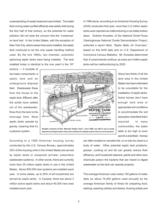
9 understanding of waste treatment was limited. The belief that running water purified effluents was widely held during the first half of that century, so the potential for water pollution did not raise the concern that the “nuisances” on land had. In the United States, with the exception of New York City, where sewer lines were installed, the septic tank continued to be the only waste handling method used. By the mid 1880s, two chamber, automatic siphoning septic tanks were being installed. The tank installed today is identical to the one used in the 19th century — it consists of two basic...
Open the catalog to page 10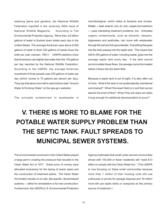
10 The environmental movement in the United States played a large part in creating the pressure that resulted in the Clean Water Act of 1977. Great sums of money were allocated exclusively for the laying of sewer pipes and the construction of treatment plants. The Clean Water Act funded virtually no on-site, site specific, decentralized systems — either for remediation or for new construction. Furthermore, the USEPA (U.S. Environmental Protection Agency) estimates that small under-served communities (those with 100,000 or fewer residents) still “need $13 billion to comply with the Clean...
Open the catalog to page 11All Norweco catalogs and technical brochures
-
PHOS-4-FADE®
2 Pages
-
SINGULAIR R3® GREEN
6 Pages
-
SINGULAIR R3®
6 Pages
-
SINGULAIR® SOLAR
2 Pages
-
SINGULAIR HK™ GREEN
6 Pages
-
CHEMCHECK ®
1 Pages
-
SINGULAIR
6 Pages
-
SINGULAIR GREEN
6 Pages
-
HYDRO-KINETIC ® FEU
6 Pages
-
Thinking Outside The Box
4 Pages
-
Charmed ,I'm Sure!
4 Pages
-
tRI-MAX TM
2 Pages
-
bIO-DYNAMIC
8 Pages
-
Lift-rail TM
6 Pages
-
Posaprime
6 Pages
-
BK 2000
6 Pages
-
SINGULAIR® TNT
1 Pages
Archived catalogs
-
pump station POSAPRIME
6 Pages
-
pump station LIFT-RAIL
6 Pages



























